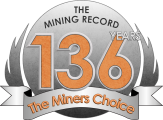A-J Gold Project Nine Hole Drilling Program
A-J Gold Project Nine Hole Drilling Program
VANCOUVER – Belmont Resources Ltd. reported on the A-J 2023 2,000 meter, nine drill hole A-J drilling program in southern British Columbia. The North Zone – Drill holes AJ23-01-05 – drilling involved exploring largely untested, open ground in the northern portion of the property where targets were chosen between the Golden Crown and Athestan-Jackpot mines. Drill assays are pending.
The South Zone – Athelstan mine area – Drill holes AJ23-06-09 – drilling involved testing for potential mineralized feeder systems along and directly beneath the Athelstan mine, one of two historic gold mines on the A-J 1.5km mineralized gold trend and related historic mine workings.
Initial results have been received for South Zone, Athelstan mine area for drill holes AJ23-06 – AJ23-09. All four drill holes  (AJ23-06, AJ23-07, AJ23-08, and AJ23-09) beneath the Athelstan gold mine intercepted over 100 meter duration of extensive silicic and phyllic alteration accompanied by widespread sulphide mineralization. These zones included multi-metre quartz shear and stockwork style vein intersections with all lithologies hosting widespread pyrrhotite and pyrite and lesser chalcopyrite and arsenopyrite.
Although long grades of gold mineralization were intercepted (up to 150m) the grades were minimal with only two gold intercepts of note: AJ23-07 from 28m: 3.8 meters @ 0.4 g/t Au including 1.9m @ 0.60 g/t Au; and AJ23-08: from 26m depth: 1.1 meters @ 1.1 g/t Au.
The long grades of gold mineralization albeit low grade, correlates in most part with the extensive quartz veining, semi-massive pyrite, pyrrhotite, and sulphides along with intensely phyllic alteration as reported in previously.
DH AJ23-07 Abundant brittle fracturing and pyrrhotite mineralization in intensely silicic altered plutonic host rock
This is a strong indication of a “peripheral alteration zone to a deep-seated copper-gold porphyryâ€. The surficial gold along the mineralized trend of the south zone and even the low gold mineralization in the drill core is interpreted as major structural seepage from this porphyry. This major structure may refer to the Jackpot fault which may be providing a conduit for hydrothermal mineralized fluids to travel from the porphyry to the surface.
As for a deep seated porphyry model, one model suggests that there may be in fact linkage between the A-J property and Belmont’s nearby CBC property where exploration is also targeting a large copper-gold porphyry system at depth.
George Sookochoff, President & CEO, said, “While the Athelstan zone may serve as the feeder system for the 7,000 ounces of gold mined from the 2 gold mines as well as an estimated resource of 2,000-5,000 ounces of gold in the surface and near surface mineralized areas, based on previous trenching results and sampling of mine dumps, the presence of extensive quartz veining, semi-massive pyrite, pyrrhotite, and sulphides, coupled with intensely phyllic alteration, strongly indicates our proximity to the target.
Our updated database provides exploration vectors pointing eastward, specifically towards the Jackpot gold mine and the Jackpot fault which is where we will focus our 2024 drill program.â€




Comments (0)